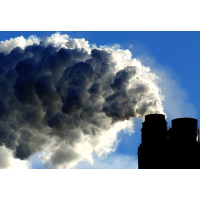U.S. Carbon Emissions to Hit 18-Year Low
 (photo: John Giles, PA)
(photo: John Giles, PA)
Halfway through his presidency, the U.S. is more than halfway toward achieving Barack Obama’s goal, announced at the Copenhagen climate summit in 2009, of cutting carbon emissions that cause global warming by 17% from 2005 levels by 2020, according to a report released last week. Compiled by Bloomberg New Energy Finance (BNEF), a provider of news, research and analysis on renewable energy and new energy technology, for the Business Council for Sustainable Energy (BCSE), a trade group promoting energy efficiency, natural gas, renewable energy, and related sectors of the economy, the report states that America’s greenhouse gas emissions have already fallen 10.7% from the 2005 baseline.
Confirming the findings of a 2012 study by the independent think tank Resources for the Future, the BNEF report found that carbon dioxide emissions fell by 13% in the past five years, to their lowest levels since 1994. Contrary to those who have stressed the role of the Great Recession in cutting emissions by reducing demand for energy, the report points out that U.S. energy use fell 6.4% from 2007 to 2012 even as GDP grew 3%. Although energy demand did dip during 2009, the worst year of the recession, it has since recovered.
The primary reasons for the emissions reductions are new energy-saving technologies, steady growth of renewables (wind, solar, hydro, etc.) and a sharp increase in the use of natural gas—instead of coal or oil—to generate electricity, according to the report. Specifically, from 2007 to 2012, natural gas rose from 23.4% of total energy consumption to 27.2%, while renewables leapt from 6.4% to 9.4%. At the same time, coal dropped from 22.5% to 18.1% and oil fell from 39.3% to 36.7%.
A major factor in the growth of renewable energy sources has been decreased cost. The installed cost of solar power in the U.S. has dropped 45% since 2009, and the cost of electricity generated by average large solar power plants has fallen by 55%, from 31 cents per kilowatt-hour to 14 cents. Over the same period, the cost of power from a typical large wind farm has declined by 11%, from 9 cents per kilowatt-hour to 8 cents. Not including hydropower, U.S. renewable energy capacity has nearly doubled in the past 4 years.
Last year, 488,000 Americans chose to buy hybrid or plug-in vehicles, which also contributed to the reduction in greenhouse gases.
The fact that much of the emission reduction occurred because of a rise in natural gas use represents a double-edged sword. Although burning natural gas to generate electricity yields about half the carbon emissions of burning coal, it can only slow, not stop, the advance of climate change. The natural gas boom also relies heavily on hydraulic fracturing, or fracking, which presents serious environmental concerns of its own, including groundwater contamination and earthquakes.
-Matt Bewig
To Learn More:
US Carbon Emissions Fall to Lowest Levels since 1994 (by Suzanne Goldenberg, The Guardian)
Sustainable Energy in America 2013 Factbook (pdf)
U.S. Leads the World in Cutting CO2 Emissions…With Help from Fracking and Poor Economy (by Noel Brinkerhoff, AllGov)
- Top Stories
- Unusual News
- Where is the Money Going?
- Controversies
- U.S. and the World
- Appointments and Resignations
- Latest News
- Musk and Trump Fire Members of Congress
- Trump Calls for Violent Street Demonstrations Against Himself
- Trump Changes Name of Republican Party
- The 2024 Election By the Numbers
- Bashar al-Assad—The Fall of a Rabid AntiSemite






Comments